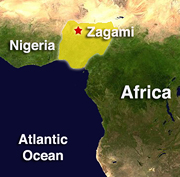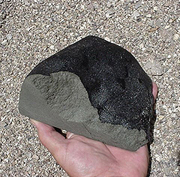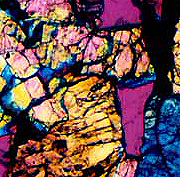Official Name:
Zagami bears the name of an immense rock near where it fell.
Location:
A little more than one kilometre north of the Zagami Rock, in Katsina Province, Nigeria.
Fall or Find:
Fall
Date:
3 October 1962, in the afternoon.
Mass Recovered:
This meteorite weighs 18.1 kilograms. It is the largest of all the Martian meteorites.
Number of Fragments:
A single fragment was recovered.
Crater:
The meteorite was found in a depression approximately 60 centimetres deep.

Enlargement
Zagami Rock is located in northwestern Nigeria, Africa. |
|

Enlargement
Slice of the Martian achondrite showing its fine-grained texture. |
|
Circumstances:
The stone landed three metres from a farmer who was trying to chase crows from his cornfield. The man heard an enormous explosion and was shaken by the shock wave as the meteoroid passed through the atmosphere. The meteorite fell at his feet with a dull thud. Once his surprise and the dust cloud had dissipated, he picked up the stone.
History:
After its discovery, the meteorite was taken to the museum in Kaduna, the provincial capital. It was exhibited there, intact, for a number of years. In 1988, the collector Robert Haag went to the museum. He offered the director a collection of several famous meteorites in exchange for a Nigerian meteorite. The director offered him a fragment of the Udei Station octahedrite. Embarrassed about offering only one fragment, he asked Haag if he would also like to have a fragment from the stony meteorite that fell in Zagami. That was exactly what the collector was hoping for! He left the country with almost one third of the precious achondrite.
Type:
Stony meteorite
Class:
Achondrite
Group:
SNC-more precisely, a shergottite. This basaltic rock comes from the crust of the planet Mars.

Enlargement
The shiny black fusion crust is clearly visible on this fragment of Zagami. This is the fragment that Robert Haag has kept in his personal collection. |
|

Enlargement
Thin section of the Zagami meteorite seen in polarized light. Inspired by the colours of meteorite thin sections, an artist made this micrograph. |
|
Composition:
Zagami has a shiny black fusion crust typical of shergottites. It differs from other specimens in its group by the small size of the minerals that make it up. They are so fine that it is difficult to examine them without a magnifying glass.
Its internal structure shows evidence of shock incidents. The stone is crisscrossed with black melt veins from 1 to 100 micrometres wide. The minerals that make up these structures form when there is an increase in temperature and pressure.
The Zagami meteorite is mainly composed of two pyroxenes: augite and pigeonite. These minerals make up 75% of its volume.
Scientific contribution:
Gases are trapped in the shock-melted glass of the Zagami meteorite. The ratios of nitrogen, argon, and xenon match the data recorded by the Viking probe in Mars' atmosphere. These analyses provide compelling evidence that achondrites in the SNC group come from our neighbouring planet, Mars.
Martian meteorites have fallen twice on an October 3-Zagami in 1962, and Chassigny in 1815. Some scientists suggest that this is not a coincidence. These SNC meteorites might come from a single impact on the red planet. The ejected meteoroids would follow the same orbit. Every year, the Earth would cross this orbit, sometimes meeting up with a meteoroid.
Comments:
One fragment of the Zagami meteorite went back to its home planet after 34 years on Earth. The Mars probe Global Surveyor, launched in 1997, had a piece of the meteorite on board. This symbolic gesture was meant to honour the achievements of space researchers. Science today not only allows us to recognize a rock that is not from Earth, but also lets us send it back where it came from!
Part of the Planétarium's collection:
Yes